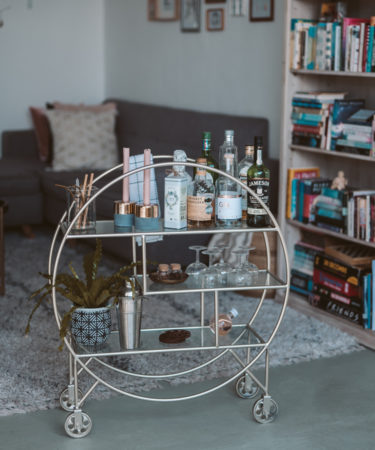It’s easy to make drinks behind a bar when there is a wholesome selection of equipment at one’s disposal, efficient ways to clean bar tools and reset for the next round of drinks, and a seemingly endless supply of quality ice. Bartending at home, however, is, in most cases, the polar opposite of this experience: working with the bare minimum on all fronts — fewer tools, a sink that may just be a bit too far away for convenience, and a set supply of quality ice that dwindles rapidly after making a couple rounds of drinks.
As we aim to be the best drink slingers and entertainers at home for both ourselves and others — whether it be in person or virtually — it’s important to keep in mind that we need to work within our limits, and make due with what we’ve got. With that in mind, we asked bartenders for their vital tips and tricks to making the best quality drinks at home, all the while striving to be better home bartenders.
1. Invest in the right tools
We can’t ask an artist to paint a picture without giving them the tools and elements to do so. The same applies to bartending at home. (No, Uncle Joe, we can’t make you “one of those fancy drinks” without bar tools or the ingredients to do so.) While there are makeshift options available in most kitchens, investing in a set of tins, a proper jigger to measure, a bar spoon, and the mixing essentials is crucial. (Cocktail Kingdom is a staple for most bartenders and enthusiasts.)
“A good Hawthorne strainer and cone mesh strainer will work much better than whatever flimsy one came in a kit,” says David Mor, bartender at Chicago’s Bad Hunter and founder of hospitality industry publication Spill.
2. Use quality ingredients
Professional bartenders also recommend not skimping on mixing ingredients, which truly make a difference in the overall caliber of the cocktail.
“Choose a good selection of premium spirits and vermouth[s],” Salvatore Calabrese, legendary bartender, author, and founder of the premium liqueur, Acqua Bianca, says. “Don’t make the mistake of thinking that mixing is a reason to use cheap alternatives.”

“Just as a chef will master the classic methods of fine cuisine before going on to be more creative… a bartender must begin with the basics and then go a step further and experiment with flavor,” says Calabrese.
3. Know the classics
The classics are the bedrock from which all other cocktails are born. Without having a compendious understanding of these templates, the likelihood of mixing up something undrinkable is significant.
“Classics give you understanding of flavor profiles, and the way different balances can suit a particular mood,” Ryan Chetiyawardana (a.k.a Mr. Lyan), renowned bartender and owner of Cub and Lyaness in London, Super Lyan in Amsterdam, and Silver Lyan in Washington, D.C., says. “They also give you an easy guide on how to incorporate flavors and ingredients together to make your experiments less wasteful.” Chetiyawardana recently collaborated with Masterclass to develop a mixology course for home bartenders — a great place to start for perfecting the classics.

4. Learn to batch
Cocktails can sometimes be fussy to make, and difficult to keep up with at home for a small group. Batching ingredients ahead of time can help with efficiency and consistency, so learning how to successfully batch at home is helpful. “Any cocktail with a fairly high alcohol content can be batched and placed in the freezer,” Mor says. “But beware if the cocktail is lower on the alcohol content, or has some syrups and low-ABV ingredients in it. You’ll create a slush of a mess.”
When it comes to entertaining others, batching also allows us to be present in the moment and not be overly distracted with the mixing process. “It will be less stressful and enable you to enjoy the company and present an enjoyable drink with ease,” Calabrese says. “A perfect style of drink to batch would be a Negroni as you can pre-mix all the ingredients and store in the fridge until ready to serve, and simply pour over ice and add a slice of orange to bring some freshness to the drink.” Other batch-friendly cocktails include the Martini, Sazerac, Old-Fashioned, and Manhattan.

Another way to get creative with batching is with French press cocktails. (Check out VinePair’s ultimate guide to French press cocktails here.)
5. Get creative with the cupboard
Simplicity shouldn’t stunt creativity. Taking the time to make custom ingredients that are multi-faceted and have depth of flavor can make a simple three-part cocktail that is bursting with flavor and complexity. “The easiest way to flex creativity and try something new is to utilize spices and dry ingredients in your cupboards in making syrups, infusions, and tinctures,” Mor says. “When I told my mom she could make a coriander syrup by using her ground coriander, white sugar, and water, it blew her mind.” Fresh herbs, fruits, and vegetables in the fridge also come in handy for some of these creative endeavors.
6. Share your recipes
Another important part of bartending is sharing your creations, and whether at a bar or at home, consumer feedback is essential. Being able to communicate recipes and concepts with others through photos or words can be inspirational and educational to other enthusiasts who are eager to try something new; and connecting with others over shared interests is a great way to build community.
For those interested in sharing their creations on their Instagram feeds or elsewhere, Mor recommends demonstrating the process, as well as sharing the recipe. “I focus on posting videos of myself making the drinks and talking through, step-by-step, the process of how to measure the ingredients, shaking and stirring techniques, and garnishing,” Mor says. He then posts the recipe in the caption so others can replicate it at home.
Chetiyawardana believes it’s important to keep presentation simple and relevant to your audience. “But make it personal,” he adds. As those following your drink-making will likely find, “It’s much more interesting to know what’s interesting to you.”
